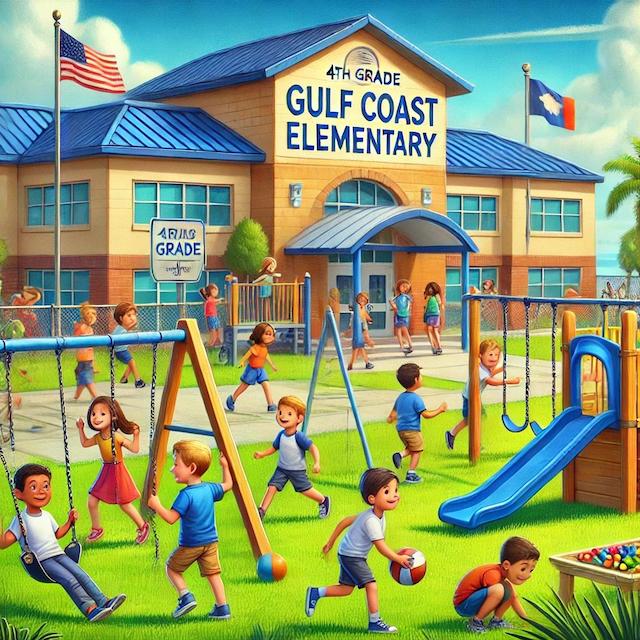Last updated on August 31st, 2025 at 05:13 pm
For many homeowners without school-age children, living in an area with great schools might seem irrelevant. However, the value of great schools extends far beyond just providing education. Great schools will directly impact property values, neighborhood stability, and community development. Whether you have children or not, the quality of local schools should be a major consideration when purchasing a home.
This article focuses on K-12 and not community colleges and 4-year institutions. Another article will discuss college-level education and how that may affect the value of homes.
Why School Quality Matters to Homeowners
A well-rated school district is one of the strongest factors influencing real estate values. Homebuyers, particularly families with young children, prioritize good schools when selecting a neighborhood. Even if you don’t have children, owning property in a well-rated district translates to strong demand, better resale value, and lower crime rates.
Mississippi’s Success: A Case Study in Educational Improvement
Recent national test results have revealed a remarkable transformation in Mississippi’s education system. Mississippi 4th graders now rank number one in the nation in both math and reading according to the latest National Assessment of Educational Progress (NAEP) results. This surge in academic achievement provides a concrete example of how improving schools can elevate a community’s status and desirability.
Mississippi’s educational improvement has led to increasing property values in districts where these schools are located. Families seeking high-quality education are more likely to move into these areas, increasing demand for housing and driving up real estate prices. The lesson? Investing in education is not just beneficial for students—it benefits entire communities.
How School Ratings Influence Home Prices
To understand the impact of school quality on property values, let’s analyze data from real estate markets across the country. The following factors highlight the correlation:
- Higher Property Values – Homes in highly rated school districts typically sell for 10-20% more than comparable homes in lower-rated districts.
- Increased Demand – Properties in areas with top-ranked schools often experience shorter time on the market and attract multiple offers.
- Lower Crime Rates – Good schools contribute to more stable communities, often leading to reduced crime rates.
- Stronger Economic Growth – More desirable schools attract businesses and professionals, boosting the local economy.
Chart: Median Home Prices by School Rating
Below is a visual representation of the relationship between school ratings and median home prices.
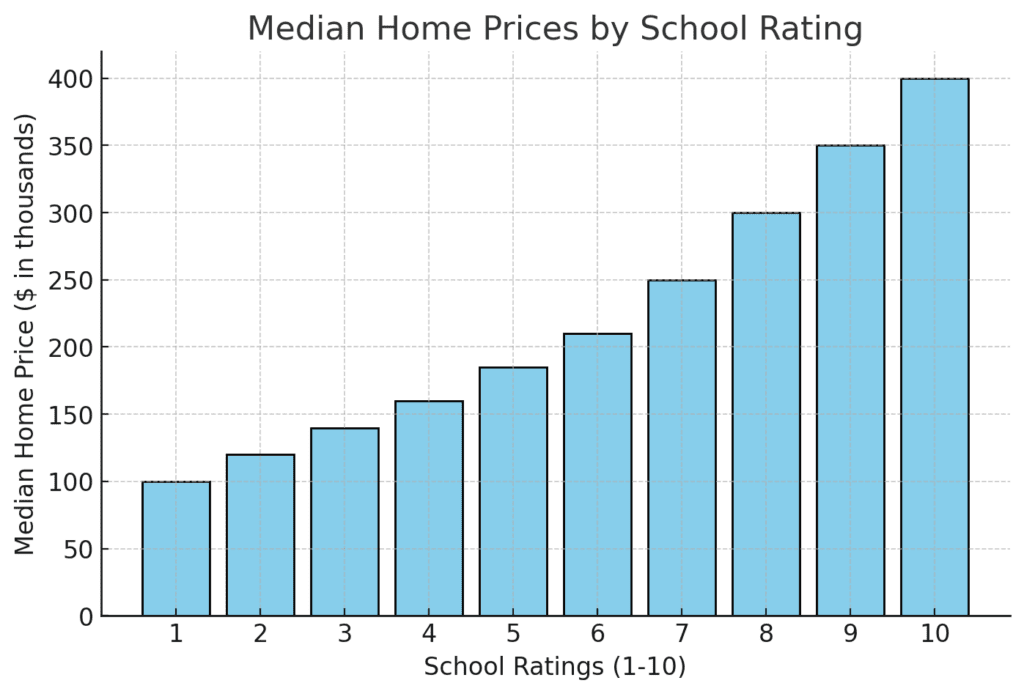
How Schools Are Rated
School quality is generally rated on a 1-10 scale, with 10 being the best. These ratings are determined by multiple factors, including:
- Standardized test scores
- Graduation rates
- Student-teacher ratios
- College readiness
- Parental and community involvement
Interestingly, it is not uncommon for an elementary school to be rated lower than a local high school, or vice versa. Homebuyers should examine the entire school district’s ratings rather than focusing on just one school.
Graph: School Ratings vs. Real Estate Appreciation
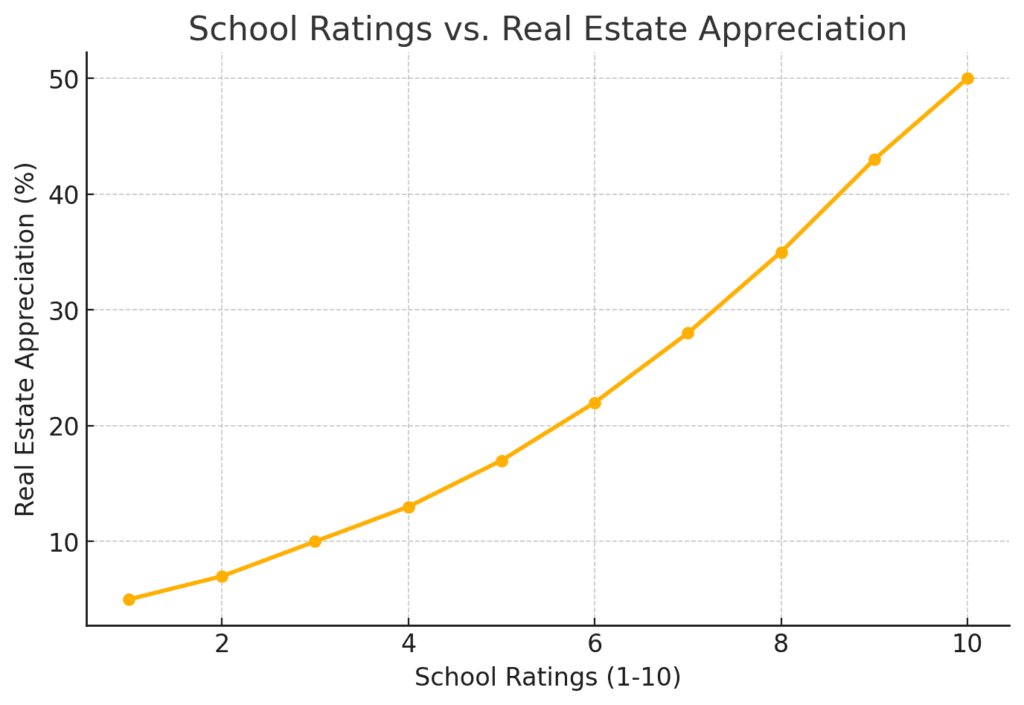
What If You Don’t Have Children?
If you don’t have school-age children, you might wonder why you should be concerned about school ratings. The answer is simple: Better schools mean better neighborhoods. The benefits of living in an area with high-performing schools extend beyond just education. Such areas tend to be well-maintained, have lower crime rates, and attract professionals who invest in their homes and communities.
Crime Rates and School Performance: A Correlation
Crime rates and school performance are often inversely related. Data suggests that:
- Poor-performing schools are frequently found in high-crime areas.
- Well-performing schools tend to be in safer neighborhoods.
- Neighborhoods with active parent involvement see both reduced crime and better school performance.
A study comparing crime rates and school performance found that areas with schools rated 7 or higher on a 10-point scale had 30% lower crime rates than areas with schools rated 4 or lower.
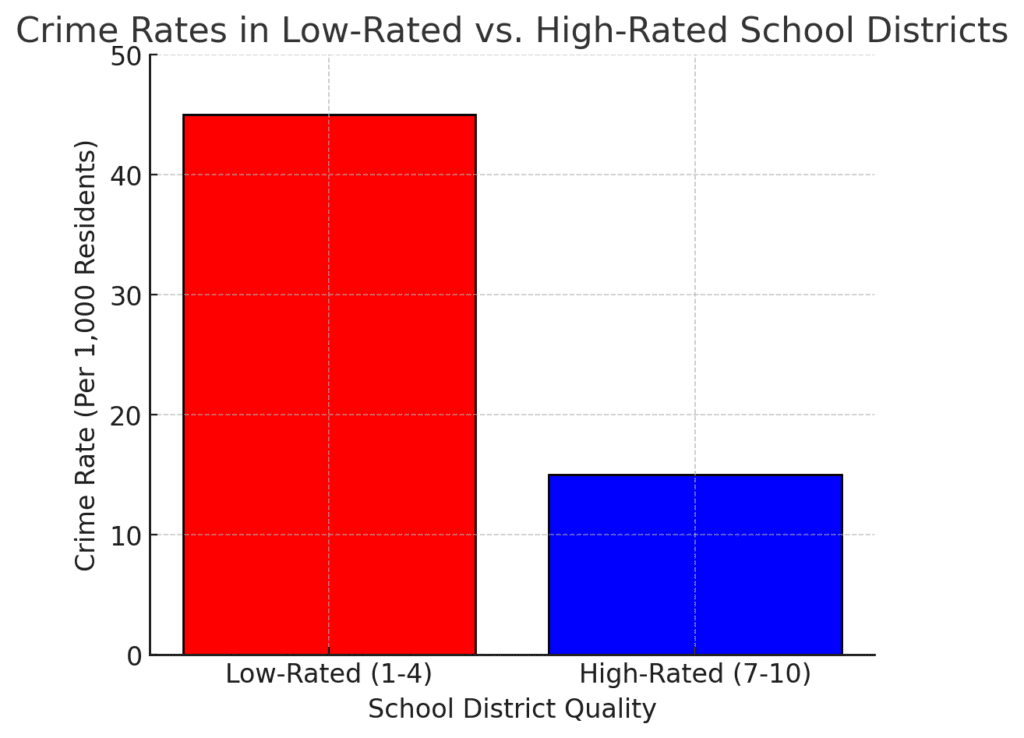
Transitional Neighborhoods: Investing in Emerging Areas
Some of the best real estate investments are in areas where schools are improving. When a district shows signs of increasing test scores, improved facilities, and greater parental involvement, property values tend to rise.
Homebuyers willing to invest in a transitioning neighborhood can see tremendous returns over time. If you purchase a home in a district where school performance is on the upswing, your property value may rise significantly as demand grows. For young families, this means they can start in an affordable area and benefit from both improving schools and increasing home equity over time.
Do Higher Property Taxes Mean Better Schools?
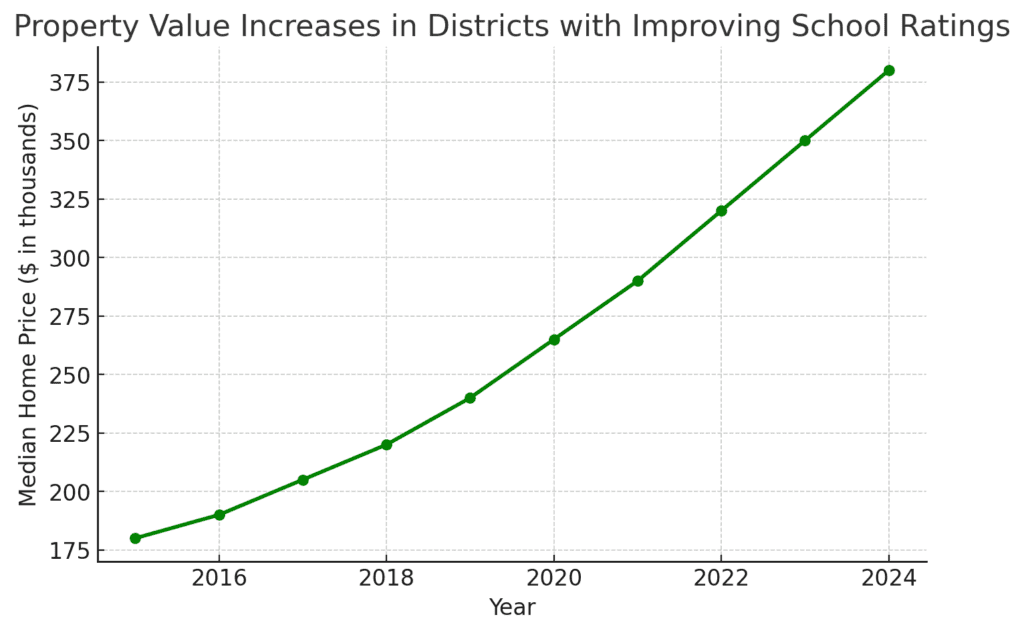
One common argument against school funding through property taxes is that people without children should not have to contribute. However, research consistently shows that higher property taxes in well-funded districts translate to better schools, which in turn lead to stronger property values.
For example, a study of suburban communities in Texas found that every additional $1,000 in annual property taxes corresponded with a 3% increase in property value due to the funding of better schools, parks, and public safety.
Final Thoughts: Schools Are a Pillar of Strong Communities
The next time the topic of property taxes and school funding arises, consider the broader impact that quality schools have on the community. Even if you do not have children, a good school system directly benefits you by:
- Increasing the value of your home
- Strengthening neighborhood stability
- Reducing crime rates
- Enhancing the local economy
Mississippi’s recent success in education serves as a reminder that investing in schools is investing in the future of the community. Whether you are buying a home or simply looking to understand property values, remember that a thriving school district is the foundation of a thriving neighborhood.
Impact of Vocational High School Programs on the Local Labor Market
While this article does not directly impact the value of homes, high schools that produce talented graduates with skills benefit the entire area and do translate into maintaining or improving the economic circumstances of residents. This translates to higher property values.
The labor market benefits immensely when high schools offer vocational training in trades such as plumbing, electrical work, carpentry, HVAC repair, and other skilled manual labor fields. These courses provide students with practical, hands-on skills that directly prepare them for the workforce, bridging the gap between education and employment. For local businesses, this results in a stronger, more affordable, and more readily available labor pool.
1. Filling the Skilled Labor Gap
Many industries, particularly construction and skilled trades, are experiencing a shortage of qualified workers. High school vocational programs help solve this issue by training students early, ensuring a steady pipeline of skilled workers for local businesses.
🔹 Skilled Labor Shortage Statistics:
- The Associated General Contractors of America (AGC) reports that 80% of construction companies struggle to find skilled workers.
- The National Electrical Contractors Association (NECA) projects a shortage of 85,000 electricians by 2030.
- The U.S. Bureau of Labor Statistics estimates 500,000 open positions in the skilled trades by 2026.
💡 Solution: High school vocational programs directly feed into local labor needs, reducing the burden on businesses searching for qualified employees.
2. Lower Hiring Costs for Local Companies
When vocational training is built into the high school curriculum, businesses spend less on recruitment and training, resulting in significant cost savings.
🔹 Benefits for Employers:
✔️ Less training required – Graduates come job-ready, reducing onboarding time.
✔️ Lower hiring costs – Fewer recruitment efforts are needed to find qualified workers.
✔️ Higher employee retention – Workers trained locally are more likely to stay in their community.
✔️ Better work quality – Professionally trained workers improve service and efficiency.
💡 Example: A local electrical company that hires from a high school vocational program saves thousands in hiring and training costs compared to bringing in workers from other states.
3. More Employment Opportunities for Graduates
Students who complete vocational programs in high school have a direct pathway into well-paying jobs right after graduation, often without needing to take on college debt.
🔹 Job Placement Advantages:
- Immediate Employment: Many graduates are hired right out of high school.
- Apprenticeship Opportunities: Students can enter paid apprenticeships with local unions and companies.
- Higher Earning Potential: Skilled tradespeople often earn more than many college graduates.
📊 Average Annual Salaries in Skilled Trades (U.S. Bureau of Labor Statistics, 2024):
- Electrician – $65,000
- Plumber – $63,000
- Carpenter – $55,000
- HVAC Technician – $60,000
💡 Example: A high school graduate with electrical training can start at $18-$22 per hour, while an apprentice can earn $40,000+ in their first year and over $80,000 within five years.
4. Great Schools Strengthen the Local Economy
When local schools provide career training in skilled trades, communities benefit economically in multiple ways:
🔹 Economic Benefits of High School Vocational Programs:
✔️ Lower Unemployment Rates – More students enter the workforce immediately.
✔️ Higher Local Business Productivity – Companies can expand faster with readily available labor.
✔️ Stronger Local Spending – Higher wages mean more money circulates within the community.
✔️ Fewer Social Assistance Needs – Fewer unemployed young people relying on government aid.
💡 Example: A town that prioritizes trade education in high schools sees a boost in local business growth, as contractors, electricians, and repair services hire from within the community rather than outsourcing.
5. Encouraging Entrepreneurship
Vocational training doesn’t just create workers—it creates entrepreneurs. Many students who graduate from high school with skills in plumbing, electrical work, or carpentry eventually start their own businesses, further boosting the local economy.
🔹 Paths to Business Ownership:
- Independent Contractors: Many skilled workers become self-employed after gaining experience.
- Local Business Growth: More skilled workers mean more small businesses in construction, home repair, and specialty services.
- Job Creation: Local businesses hire more employees, further strengthening the economy.
💡 Example: A student trained in HVAC repair in high school starts a business at 25, hires apprentices, and creates new jobs in the community.
6. Reducing College Debt & Expanding Career Options
Not all students want or need to attend a four-year university. High school vocational programs provide an alternative career path that allows students to earn good wages without accumulating massive college debt.
🔹 Cost Comparison: College vs. Trade School (2024):
- 4-Year College Degree: $100,000+ in student debt, uncertain job market.
- Trade School Certification: $5,000-$15,000, immediate employment in a high-demand field.
💡 Example: A student who chooses plumbing over a traditional college degree earns a full salary by age 20, while their college-educated peers are still in debt.
Final Thoughts: A Win-Win for Communities
When high schools offer trades-based education, everyone benefits:
✔️ Students get well-paying jobs immediately after graduation.
✔️ Businesses save money by hiring skilled, job-ready workers.
✔️ Communities grow stronger as unemployment decreases and spending increases.
✔️ The local economy thrives as skilled trades fuel small business growth.
Perhaps the most important point here is that your children will remain in the area close to family. There is no reason why so many high school graduates need to leave their communities looking for work. You and your neighbors can have a positive impact by insisting that your local high school provides classes in the various trades. Keep your children in your community as they begin to form their families.
The Takeaway:
Investing in vocational training isn’t just about education—it’s about strengthening the workforce and economy. Schools that prioritize trade education create sustainable, self-sufficient communities with lower unemployment, higher wages, and greater economic stability.
How can I help create great schools in my area?
Schools are a cornerstone of every community. Whether or not you have children attending them, their success directly impacts property values, crime rates, and economic growth. Strong schools mean stronger communities, which benefit everyone. Here’s how all residents, regardless of parental status, can contribute to improving school infrastructure and student performance.
1. Advocate for Better School Funding
Even if you don’t have children in school, your tax dollars contribute to school funding. Well-funded schools tend to have:
✔️ Better facilities (modern classrooms, libraries, labs)
✔️ Higher-quality teachers (competitive salaries attract experienced educators)
✔️ More student resources (books, technology, extracurricular activities)
Before you advocate for better school funding, be sure that the funding is going to the right place. There are issues across the country where increased school funding went to administrative budgets and not to classrooms. You can help by becoming an advocate for accountability in school budgets.
Ways You Can Help:
- Vote in local elections: School board members and budget decisions directly impact funding.
- Support school bonds & levies: These fund infrastructure improvements and educational programs.
- Engage in community discussions: Attend town hall meetings on school funding.
💡 Example: Many districts have seen improvements when local residents support funding for school renovations, ensuring safer and more effective learning environments.
2. Volunteer Your Time & Skills
Even if you don’t have kids, you can make a difference by giving your time. Schools often need extra hands for various activities.
Ways You Can Help:
- Mentor students: Help with career advice, college applications, or financial literacy.
- Assist with tutoring programs: Even 1-2 hours a week can boost student achievement.
- Join a school advisory board: Offer your expertise in finance, construction, or other fields.
- Help with after-school programs: Support clubs, sports teams, or special events.
- Join the PTA: You do not need children to be elected to the Parent Teachers Guild or to participate.
💡 Example: Retired professionals often make excellent mentors, helping students connect classroom learning with real-world applications.
3. Support Local Businesses That Invest in Great Schools
Businesses play a huge role in school funding. Many corporations sponsor technology programs, after-school activities, or teacher grants.
Ways You Can Help:
- Shop at businesses that support local schools (Many donate a portion of profits to education).
- Encourage your employer to partner with schools (internships, donations, career workshops).
- Sponsor school fundraisers (Donate items or services for auctions).
💡 Example: Some businesses provide free Wi-Fi for students who lack home internet access, bridging the digital divide.
4. Promote a Culture of Education & Literacy
A community that values education creates motivated students. You can help create a culture that prioritizes learning.
Ways You Can Help:
- Donate books to local schools or libraries.
- Support literacy programs (Read to young children, host book clubs).
- Encourage high expectations for all students (Celebrate academic success).
- Advocate for STEM and vocational training programs (Ensure all students have career pathways).
- Examine the curriculum (remove political distractions)
💡 Example: Cities with strong public libraries often see higher student literacy rates and improved test scores.
5. Improve School Safety & Infrastructure
Safe and well-maintained schools create better learning environments. Community members can push for improvements in school safety and infrastructure.
Ways You Can Help:
- Support neighborhood watch programs around schools (Reduce crime near school zones).
- Advocate for safer crosswalks and school bus routes.
- Report maintenance issues (A broken light or unsafe playground equipment affects students).
- Push for school sustainability projects (Solar panels, recycling programs).
💡 Example: Parents and non-parents alike have successfully lobbied for improved lighting around schools, leading to safer environments for students.
6. Engage with Local Students & Schools
The more the community engages with its schools, the more students feel supported.
Ways You Can Help:
- Attend school plays, concerts, and sports events.
- Sponsor scholarships for local students.
- Encourage local media to highlight school achievements.
- Invite students to participate in community projects (gardening, clean-ups, mural painting).
💡 Example: A town that celebrates academic and athletic achievements creates pride and motivation among students.
Why This Matters
Even if you don’t have children in school, investing in education benefits everyone:
✔️ Higher property values – Good schools increase real estate demand.
✔️ Lower crime rates – Strong schools create engaged, productive citizens.
✔️ Stronger economy – Well-educated students lead to a more skilled workforce.
✔️ Better quality of life – Vibrant schools create vibrant communities.
Final Thought:
A great school system isn’t just for parents—it’s for the entire community. Whether you vote, volunteer, donate, or simply show up, your involvement matters. The better the schools, the better the neighborhood. Let’s all take part in making education a priority!
If you are looking to retire in a new area, check the quality of schools in that area.
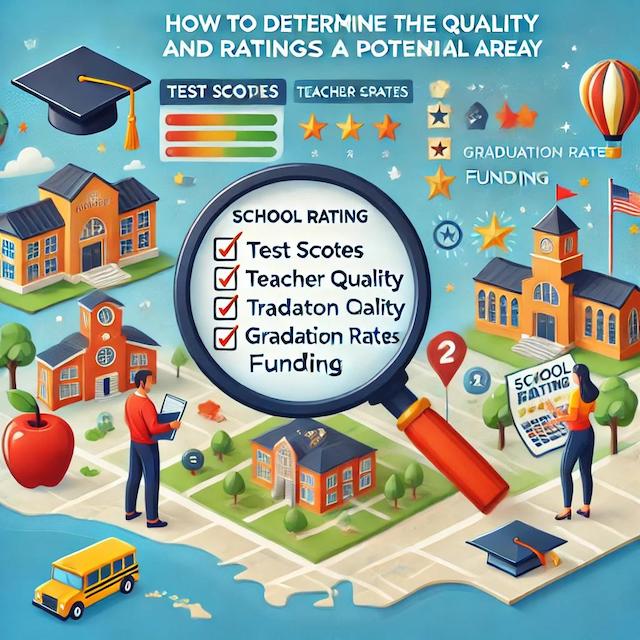
How to Determine the Quality and Ratings of Schools in a Potential Area
If you’re considering moving to a new area and want to evaluate the quality of the local schools, several resources and strategies can help you make an informed decision. Even if you don’t have school-age children, checking school ratings is important because better schools often correlate with stronger property values and safer neighborhoods. Here’s how you can assess school quality before you move.
1. Use Online School Rating Websites
Several well-established websites provide comprehensive school ratings based on factors like test scores, teacher quality, and student progress.
📌 Best Websites to Check School Ratings:
- GreatSchools.org – Provides overall ratings (1-10) based on test scores, student progress, and equity factors.
- Niche.com – Includes detailed rankings, parent reviews, and teacher quality ratings.
- SchoolDigger.com – Offers test scores, rankings, and demographic information.
- U.S. News & World Report Best High Schools – Ranks high schools based on graduation rates and college readiness.
💡 Tip: Look beyond just the rating number—read reviews, test score trends, and teacher feedback to get a complete picture.
2. Check State & Local Department of Education Websites
Each state’s Department of Education publishes annual school performance reports. These reports often include:
✔️ Standardized test scores
✔️ Graduation rates
✔️ Teacher-to-student ratios
✔️ Funding and spending per student
📌 Where to Look:
- Google “Your State + Department of Education + School Report Cards”
- Visit district websites to review their published data
💡 Tip: Some states provide interactive maps showing school district boundaries and rating trends over time.
3. Contact the Local School District
If you want the most accurate and up-to-date school information, consider reaching out directly to the district offices.
📌 Questions to Ask:
- What are the recent standardized test score trends?
- How does the school support students with different learning needs?
- What extracurricular activities and advanced placement (AP) courses are available?
- What is the student-teacher ratio?
💡 Tip: Visit the school in person if possible—see the classrooms, talk to teachers, and get a feel for the school culture.
4. Talk to Local Parents & Community Members
Ratings and test scores only tell part of the story. Local parents and community groups can provide insight into:
✔️ Teacher engagement
✔️ Student morale
✔️ Safety and discipline policies
✔️ School culture and community involvement
📌 Where to Connect with Parents:
- Facebook Groups & Nextdoor App – Many communities have parent groups discussing school quality.
- Local PTA Meetings – Parent-Teacher Associations (PTAs) are great for first-hand insights.
- Neighborhood Forums (e.g., Reddit or City-Data.com)
💡 Tip: Ask parents what they like and don’t like about the schools to get a balanced perspective.
5. Compare School District Spending & Funding Sources
A school’s funding and budget can impact its ability to provide quality education. Schools with better funding often have:
✔️ More experienced teachers
✔️ Smaller class sizes
✔️ Updated technology and facilities
📌 How to Check Funding Data:
- National Center for Education Statistics (NCES) – Provides school finance and performance data.
- State & Local Education Budget Reports – Usually available on school district websites.
💡 Tip: Compare per-student spending in different districts to see if your area prioritizes education funding.
6. Analyze Crime Rates & Neighborhood Safety
Schools in low-crime areas tend to have better academic performance. Many real estate and crime-tracking websites offer neighborhood safety ratings that correlate with school quality.
📌 Where to Find Crime Data:
- City-Data.com – Provides crime stats for different cities and school districts.
- NeighborhoodScout.com – Offers crime maps and safety scores.
- Local Police Websites – Some departments provide crime maps for school zones.
💡 Tip: Compare crime trends with school performance ratings to find patterns in school quality.
7. Consider School Performance Growth Trends
A school that has been improving over time may be a great long-term investment, even if it’s not top-rated yet.
📌 Look for:
✔️ Steady improvement in test scores over 3-5 years
✔️ New programs or funding initiatives
✔️ Community engagement in improving the district
💡 Tip: Check historical data on GreatSchools.org or state education websites to see if the school is trending upwards.
Final Thoughts: Making an Informed Decision
Whether you have children or not, researching school ratings is crucial when moving to a new area. Strong schools enhance property values, create stable communities, and provide a better living environment.
🔹 Best Steps to Take:
✅ Use online school rating sites for initial research
✅ Review state and district data for funding and test scores
✅ Talk to local parents and visit schools in person
✅ Compare crime rates and community engagement
✅ Look for schools showing consistent improvement
By doing your research, you’ll be able to confidently choose a home in a neighborhood with strong, well-supported schools.
Sources for Data used in Graphs:
School Ratings vs Real Estate Appreciation
- National Bureau of Economic Research (NBER) – Studies show that for every dollar spent on school improvements, property values increase correspondingly.
- Source: www.nber.org
- National Association of Realtors (NAR) – Reports indicate that homebuyers are willing to pay a premium for homes in high-rated school districts.
- Source: www.nar.realtor
- Redfin & Zillow Studies – Real estate data from major listing sites confirm that homes in top-rated school districts appreciate faster than those in lower-rated districts.
- Source: www.redfin.com | www.zillow.com
- Journal of Urban Economics – Research on the impact of school quality on property values highlights a direct correlation between test scores and housing prices.
- Source: www.sciencedirect.com
Median Home Prices by School Ratings – Sources
- Realtor.com® Report (2024): Homes near top-rated public elementary schools (GreatSchools ratings of 9 or 10) were found to have a median list price nearly 80% higher than homes in the surrounding county. realtor.com
- Realtor.com Study (2016): An earlier analysis revealed that home values within top-rated school districts were 49% higher than the national median home price. opendoor.com
- Brookings Institution Study: Research indicated an average difference of $205,000 in home prices between houses in high-performing and low-performing school districts across 100 of the largest U.S. metro areas. raleighrealty.com
Property Value Increases in Districts with Improving School Ratings – Sources
- Brookings Institution Study: Research by the Brookings Institution found that home values tend to be higher in areas with high-scoring schools. Specifically, there was an average difference of $205,000 in home prices between houses in high-performing and low-performing school districts across 100 of the largest U.S. metro areas. raleighrealty.com
- National Bureau of Economic Research (NBER) Report: A report titled “Using Market Valuation to Assess Public School Spending” by the NBER found a correlation between school expenditures and home values. The study indicated that every additional dollar spent in per-pupil state aid increases home values by about $20. stewartvaluation.com
- The New York Times Article: An article in The New York Times reported that economists have estimated a 5% improvement in test scores in suburban neighborhoods can raise home prices by 2.5%. raleighrealty.com
Crime Rates in Low-Rated Vs. High-Rated School Districts – Sources
Research indicates a correlation between school quality and neighborhood crime rates. A study titled “Crime and Inequality in Academic Achievement Across School Districts in the United States” found that higher violent crime rates negatively impact academic performance in English Language Arts (ELA) and Mathematics. Specifically, a 10% decline in violent crime was associated with a .04 standard deviation increase in ELA achievement by eighth grade.
This suggests that lower crime rates contribute to better academic outcomes, which can be indicative of higher-rated schools.
Additionally, the “Crime, Violence, Discipline, and Safety in U.S. Public Schools” report by the National Center for Education Statistics provides data on the prevalence of crime in schools, offering insights into the relationship between school safety and overall school quality.
While these studies do not directly compare crime rates between low-rated and high-rated school districts, they highlight the interplay between community crime levels and school performance. Communities with lower crime rates tend to have schools with better academic outcomes, which often correspond to higher school ratings.
Considering a move after retirement, great schools can help
This article can help you decide where to move in retirement. As we indicated, great schools can have a positive impact on property values. This also means that what you pay for your new retirement home will already have the quality of local schools embedded in the price.
When you see different prices for what seems to be a similar house, consider that the local schools may have an impact. I have seen house prices reflective of the quality of schools in an area. At first, you may think a home is overpriced until you do some research on the neighborhood schools.
This is not to imply that you should not move into a transitional neighborhood. Actually, you may be doing something good for yourself and the neighborhood. You will probably pay a lower price for your home and at the same time can have a positive effect on the local schools. Volunteer at the local school, and become an activist for better schools. Keep in mind that there is no national housing market. Every area has it’s own and the value that good schools bring to the local housing market is tremendous.
Our postscript
A family member of mine who is retired has been volunteering a the local elementary school for a few years. She gets tremendous gratification from helping her neighborhood even though her children are now adults. Teachers can use all of the help they can get and they constantly ask her to come to their classrooms.
I have created a series of articles about starting a business after retirement which you can reach by clicking here. This article can be a guide to help those of you who would like to help high school students understand how to start their own businesses after graduation. The articles will also give you some reasons to volunteer and perhaps even create a business around helping your neighborhood schools.
For those of you who have finance skills, please consider volunteering your time at local high schools to help teachers explain financial literacy to local kids. Your efforts there can help children down the road as they graduate.
PODCAST
Discover more from RetireCoast.com
Subscribe to get the latest posts sent to your email.

